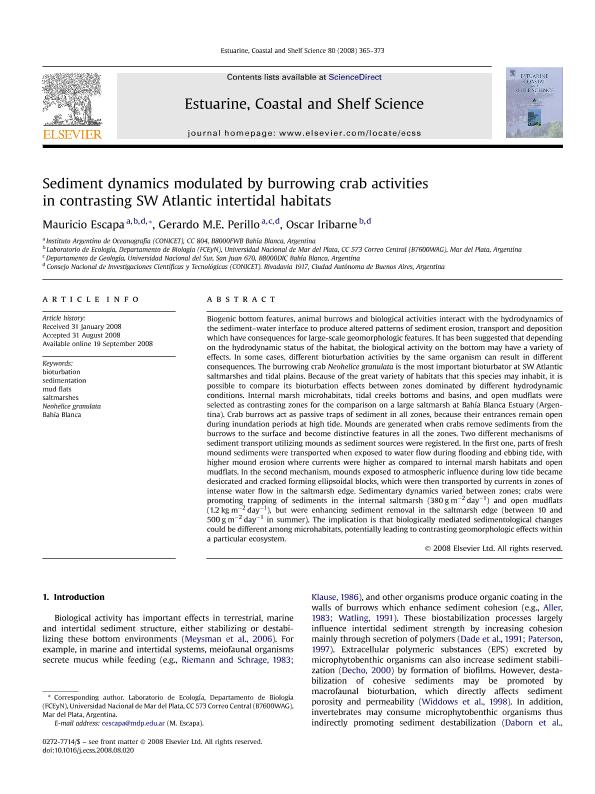Artículo
Sediment dynamics modulated by burrowing crab activities in contrasting SW Atlantic intertidal habitats
Fecha de publicación:
11/2008
Editorial:
Academic Press Ltd-elsevier Science Ltd
Revista:
Estuarine, Coastal and Shelf Science
ISSN:
0272-7714
Idioma:
Inglés
Tipo de recurso:
Artículo publicado
Clasificación temática:
Resumen
Biogenic bottom features, animal burrows and biological activities interact with the hydrodynamics of the sediment–water interface to produce altered patterns of sediment erosion, transport and deposition which have consequences for large-scale geomorphologic features. It has been suggested that depending on the hydrodynamic status of the habitat, the biological activity on the bottom may have a variety of effects. In some cases, different bioturbation activities by the same organism can result in different consequences. The burrowing crab Neohelice granulata is the most important bioturbator at SW Atlantic saltmarshes and tidal plains. Because of the great variety of habitats that this species may inhabit, it is possible to compare its bioturbation effects between zones dominated by different hydrodynamic conditions. Internal marsh microhabitats, tidal creeks bottoms and basins, and open mudflats were selected as contrasting zones for the comparison on a large saltmarsh at Bahı ́ a Blanca Estuary (Argen- tina). Crab burrows act as passive traps of sediment in all zones, because their entrances remain open during inundation periods at high tide. Mounds are generated when crabs remove sediments from the burrows to the surface and become distinctive features in all the zones. Two different mechanisms of sediment transport utilizing mounds as sediment sources were registered. In the first one, parts of fresh mound sediments were transported when exposed to water flow during flooding and ebbing tide, with higher mound erosion where currents were higher as compared to internal marsh habitats and open mudflats. In the second mechanism, mounds exposed to atmospheric influence during low tide became desiccated and cracked forming ellipsoidal blocks, which were then transported by currents in zones of intense water flow in the saltmarsh edge. Sedimentary dynamics varied between zones; crabs were promoting trapping of sediments in the internal saltmarsh (380 g m 2 day 1 ) and open mudflats (1.2 kg m 2 day 1 ), but were enhancing sediment removal in the saltmarsh edge (between 10 and 500 g m 2 day 1 in summer). The implication is that biologically mediated sedimentological changes could be different among microhabitats, potentially leading to contrasting geomorphologic effects within a particular ecosystem.
Archivos asociados
Licencia
Identificadores
Colecciones
Articulos(IADO)
Articulos de INST.ARG.DE OCEANOGRAFIA (I)
Articulos de INST.ARG.DE OCEANOGRAFIA (I)
Citación
Escapa, Carlos Mauricio; Perillo, Gerardo Miguel E.; Iribarne, Oscar Osvaldo; Sediment dynamics modulated by burrowing crab activities in contrasting SW Atlantic intertidal habitats; Academic Press Ltd-elsevier Science Ltd; Estuarine, Coastal and Shelf Science; 80; 3; 11-2008; 365-373
Compartir
Altmétricas




